| Football Route Tree |
In football, passing plays center on the routes run by the receivers. If either the quarterback or the receivers don’t know the routes for a given play, it can lead to confusion, incompletions and interceptions.
If you’re a young football player, knowing the name and design of the routes you can run will help you stay on top of your assignments and allow you to talk knowledgeably about football. If you’re someone 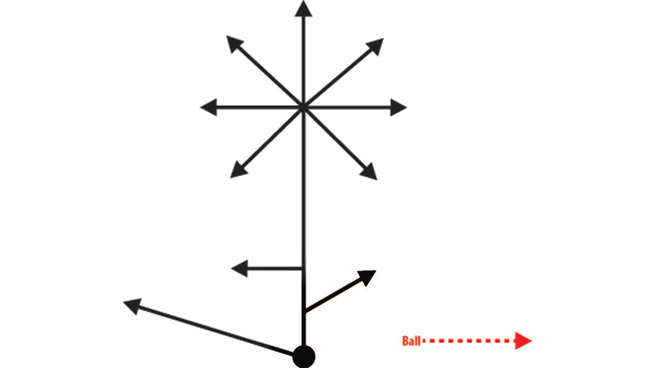 who’s new to coaching football, knowing the different routes will help you design plays and effectively communicate assignments to your players.
who’s new to coaching football, knowing the different routes will help you design plays and effectively communicate assignments to your players.
The simplest way to learn routes is through the football route tree. This is a term given to any diagram that shows the various routes a receiver can run. A route tree consists of a single straight line with other lines branching off it, depicting the various possible routes. Here is what a basic football route tree looks like.
The Flat Route
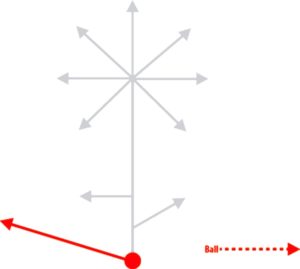 The flat route requires the receiver to run a shallow route toward the sideline. This area of the field is typically referred to as the “flat.” Typically, a flat route isn’t run deeper than 4 or 5 yards.
The flat route requires the receiver to run a shallow route toward the sideline. This area of the field is typically referred to as the “flat.” Typically, a flat route isn’t run deeper than 4 or 5 yards.
Flat routes are often run by running backs and fullbacks coming out of the backfield, although other receivers can run them as well. On a flat route, the receiver immediately turns toward the sideline and runs into the flat, gradually getting deeper downfield. As he runs the route, the receiver looks over his shoulder for the ball.
One important thing to note about running the flat route is to stay inbounds. If a receiver is 2 yards from the sideline and the quarterback still hasn’t thrown the ball, the receiver should stop running and get into an athletic position.
The Slant Route
The slant route requires the receiver to run a few steps downfield, then cut inward at a 45-degree angle.
A receiver typically is not expected to run a set amount of yardage before slanting in—rather, he’s required to take three steps downfield before cutting. Once he slants inward, his eyes should be locked on the quarterback and he should expect the ball. If the throw doesn’t immediately come his way, the receiver should continue to run at a 45-degree angle downfield until the play is over. A well-timed slant is one of the most effective routes on the football route tree.
The Quick Out Route
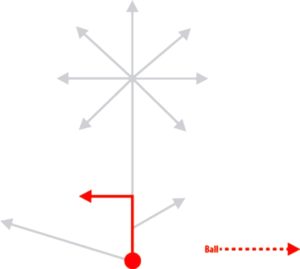 The quick out requires the receiver to run 5 yards straight downfield before cutting 90 degrees toward the sideline.
The quick out requires the receiver to run 5 yards straight downfield before cutting 90 degrees toward the sideline.
In a good quick out route, the receiver bursts off the line like he’s trying to run by the defender, then, after five yards, he executes a sharp, crisp cut toward the sideline. Once the receiver cuts out, his eyes should be on the quarterback and he should expect the ball.
It’s important that the cut be sharp and crisp so the receiver doesn’t slowly drift downfield while running toward the sideline. As with the flat route, it’s important not to run out of bounds on the quick out.
The Curl Route
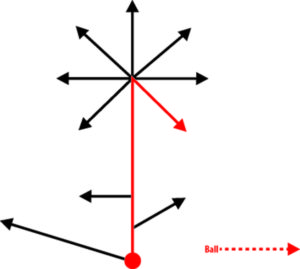 The curl route requires the receiver to run somewhere between 8 and 12 yards downfield before turning in at a roughly 135-degree angle and running back toward the line of scrimmage.
The curl route requires the receiver to run somewhere between 8 and 12 yards downfield before turning in at a roughly 135-degree angle and running back toward the line of scrimmage.
This route is also referred to as a “button hook,” or simply a “hook” route. When the receiver cuts to come back to the ball, his chest should be over his toes. This will prevent him from slipping and allow for a sharp cut. Once the receiver turns back to run toward the line of scrimmage, he should have his eyes up and be ready to receive a pass. When the ball is in the air, it’s important for the receiver to run to meet it instead of waiting for the ball to come to him.
The Comeback Route
 The comeback route requires the receiver to run somewhere between 10 and 15 yards downfield before turning out at a roughly 135-degree angle and running toward the sideline. Once the receiver turns toward the sideline, he should have his eyes up and be ready to receive a pass.
The comeback route requires the receiver to run somewhere between 10 and 15 yards downfield before turning out at a roughly 135-degree angle and running toward the sideline. Once the receiver turns toward the sideline, he should have his eyes up and be ready to receive a pass.
Like with the curl route, it’s important for the receiver to continue running after the cut. Often, the quarterback will throw the ball toward the sideline to lead the receiver and keep the ball away from the defender. Also like with the curl route, the receiver running the comeback route should have his chest over his toes when cutting.
The Out Route
 The out route requires the receiver to run somewhere between 10 and 15 yards downfield before cutting at a 90-degree angle and running toward the sideline. The route is similar to the “quick out” route, but the receiver runs further downfield.
The out route requires the receiver to run somewhere between 10 and 15 yards downfield before cutting at a 90-degree angle and running toward the sideline. The route is similar to the “quick out” route, but the receiver runs further downfield.
Like most routes on the route tree, the cut toward the sideline must be crisp and sharp. “Rounding” the out route (i.e., making a more gradual, drifting turn) gives the defender a chance to cut underneath the receiver and make a play on the ball.
The Dig Route
 The dig route requires the receiver to run somewhere between 10 and 15 yards downfield before cutting 90 degrees and running toward the middle of the field. Also known as an “in” route, the dig route is essentially a mirrored version of the out route.
The dig route requires the receiver to run somewhere between 10 and 15 yards downfield before cutting 90 degrees and running toward the middle of the field. Also known as an “in” route, the dig route is essentially a mirrored version of the out route.
Like the out route, it requires a sharp, crisp 90-degree cut to be effective.
The Post Route
 The post route requires the receiver to run somewhere between 10 and 20 yards downfield before cutting at a 45-degree angle and running toward the middle of the field. The post route gets its name from the fact that the receiver runs toward the goal posts after he makes his cut.
The post route requires the receiver to run somewhere between 10 and 20 yards downfield before cutting at a 45-degree angle and running toward the middle of the field. The post route gets its name from the fact that the receiver runs toward the goal posts after he makes his cut.
The Corner Route
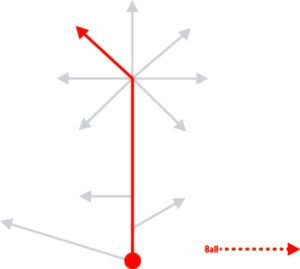 The corner route requires the receiver to run between 10 and 20 yards downfield before cutting out at a 45-degree angle and running toward the sideline.
The corner route requires the receiver to run between 10 and 20 yards downfield before cutting out at a 45-degree angle and running toward the sideline.
The corner route gets its name from the fact that the receiver typically runs toward the back corner of the end zone after making his cut.
The Streak Route (Go, Fly Route)
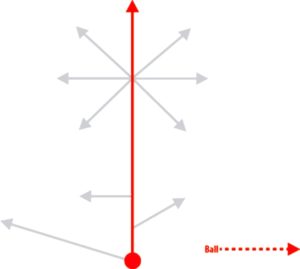 The streak route is the simplest route in the football route tree, as it only requires the receiver to run straight downfield. It is also referred to as the “fly” route or the “go” route.
The streak route is the simplest route in the football route tree, as it only requires the receiver to run straight downfield. It is also referred to as the “fly” route or the “go” route.
The streak is perhaps the simplest route in football. A fast receiver teamed up with a strong-armed quarterback can have great success on streaks if he can get behind the defense.

